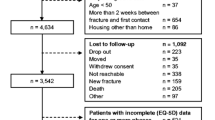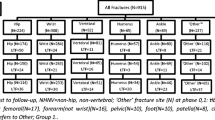Abstract
Summary
Using prospective data from the Canadian Multicentre Osteoporosis Study (CaMos), we compared health utilities index (HUI) scores after 5 years of follow-up among participants (50 years and older) with and without incident clinical fractures. Incident fractures had a negative impact on HUI scores over time.
Introduction
This study examined change in health-related quality of life (HRQL) in those with and without incident clinical fractures as measured by the HUI.
Methods
The study cohort was 4,820 women and 1,783 men (50 years and older) from the CaMos. The HUI was administered at baseline and year 5. Participants were sub-divided into incident fracture groups (hip, rib, spine, forearm, pelvis, other) and were compared with those without these fractures. The effects of both time and fracture type on HUI scores were examined in multivariable regression analyses.
Results
Men and women with hip fractures, compared to those without, had lower HUI measures that ranged from −0.05 to −0.25. Both women and men with spine fractures had significant deficits on the pain attributes (−0.07 to −0.12). In women, self-care (−0.06), mobility and ambulation (−0.05) were also negatively impacted. Women with rib fractures had deficits similar to women with spine fractures, and these effects persisted over time. In men, rib fractures did not significantly affect HUI scores. Pelvic and forearm fractures did not substantially influence HUI scores.
Conclusion
The HUI was a sensitive measure of HRQL change over time. These results will inform economic analyses evaluating osteoporosis therapies.



Similar content being viewed by others
References
Cauley JA, Thompson DE, Ensrud KC et al (2000) Risk of mortality following clinical fractures. Osteoporos Int 11:556–561
Center JR, Nguyen TV, Schneider D et al (1999) Mortality after all major types of osteoporotic fracture in men and women: an observational study. Lancet 353:878–882
Leibson CL, Tosteson AN, Gabriel SE et al (2002) Mortality, disability, and nursing home use for persons with and without hip fracture: a population-based study. J Am Geriatr Soc 50:1644–1650
Sernbo I, Johnell O (1993) Consequences of a hip fracture: a prospective study over 1 year. Osteoporos Int 3:148–153
Papaioannou A, Wiktorowicz ME, Adachi JD et al (2000) Mortality, independence in living, and re-fracture, one year following hip fracture in Canadians. J Obstet Gynaecol Can 22:591–597
Papaioannou A, Adachi JD, Parkinson W et al (2001) Lengthy hospitalization associated with vertebral fractures despite control for comorbid conditions. Osteoporos Int 12:870–874
Melton LJ III, Chrischilles EA, Cooper C et al (1992) Perspective. How many women have osteoporosis? J Bone Miner Res 7:1005–1010
Lips P (1997) Epidemiology and predictors of fractures associated with osteoporosis. Am J Med 103:3S–8S
Jackson SA, Tenenhouse A, Robertson L (2000) Vertebral fracture definition from population-based data: preliminary results from the Canadian Multicenter Osteoporosis Study (CaMos). Osteoporos Int 11:680–687
Adachi JD, Ioannidis G, Olszynski WP et al (2002) The impact of incident vertebral and non-vertebral fractures on health related quality of life in postmenopausal women. BMC Musculoskelet Disord 3:11
Silverman SL, Cranney A (1997) Quality of life measurement in osteoporosis. J Rheumatol 24:1218–1221
Papaioannou A, Kennedy CC, Ioannidis G et al (2006) Determinants of health-related quality of life in women with vertebral fractures. Osteoporos Int 17:355–363
Adachi JD, Ioannidis G, Pickard L et al (2003) The association between osteoporotic fractures and health-related quality of life as measured by the Health Utilities Index in the Canadian Multicentre Osteoporosis Study (CaMos). Osteoporos Int 14:895–904
Kreiger N, Tenenhouse A, Joseph L et al (2002) The Canadian Multicentre Osteoporosis Study (CaMos): background, rationale, methods. Can J Aging 18:376–387
Feeny D, Furlong W, Boyle M et al (1995) Multi-attribute health status classification systems. Health Utilities Index. PharmacoEconomics 7:490–502
Horsman J, Furlong W, Feeny D et al (2003) The Health Utilities Index (HUI): concepts, measurement properties and applications. Health Qual Life Outcomes 1:54
Furlong WJ, Feeny DH, Torrance GW et al (2001) The Health Utilities Index (HUI) system for assessing health-related quality of life in clinical studies. Ann Med 33:375–384
Bowker SL, Pohar SL, Johnson JA (2006) A cross-sectional study of health-related quality of life deficits in individuals with comorbid diabetes and cancer. Health Qual Life Outcomes 4:17
Lovrics PJ, Cornacchi SD, Barnabi F et al (2008) The feasibility and responsiveness of the health utilities index in patients with early-stage breast cancer: a prospective longitudinal study. Qual Life Res 17:333–345
Huang DT, Sesselberg HW, McNitt S et al (2007) Improved survival associated with prophylactic implantable defibrillators in elderly patients with prior myocardial infarction and depressed ventricular function: a MADIT-II substudy. J Cardiovasc Electrophysiol 18:833–838
Nichol G, Stiell IG, Hebert P et al (1999) What is the quality of life for survivors of cardiac arrest? A prospective study. Acad Emerg Med 6:95–102
Gold M, Franks P, Erickson P (1996) Assessing the health of the nation. The predictive validity of a preference-based measure and self-rated health. Med Care 34:163–177
Manuel DG, Schultz SE, Kopec JA (2002) Measuring the health burden of chronic disease and injury using health adjusted life expectancy and the Health Utilities Index. J Epidemiol Community Health 56:843–850
Cranney AB, Coyle D, Hopman WM et al (2005) Prospective evaluation of preferences and quality of life in women with hip fractures. J Rheumatol 32:2393–2399
World Health Organization (WHO) (1998) Guidelines for preclinical evaluation and clinical trials in osteoporosis. World Health Organization, Geneva
Brown JP, Josse RG (2002) 2002 clinical practice guidelines for the diagnosis and management of osteoporosis in Canada. CMAJ 167:S1–S34
Health Utilities Inc. (2007) HUInc: leaders in the utility assessment of health-related quality of life. Available at http://healthutilities biz
Torrance GW, Feeny DH, Furlong WJ et al (1996) Multiattribute utility function for a comprehensive health status classification system. Health Utilities Index Mark 2. Med Care 34:702–722
Cummings SR, Melton LJ (2002) Epidemiology and outcomes of osteoporotic fractures. Lancet 359:1761–1767
Osnes EK, Lofthus CM, Meyer HE et al (2004) Consequences of hip fracture on activities of daily life and residential needs. Osteoporos Int 15:567–574
Hallberg I, Rosenqvist AM, Kartous L et al (2004) Health-related quality of life after osteoporotic fractures. Osteoporos Int 15:834–841
Sawka AM, Thabane L, Papaioannou A et al (2005) Health-related quality of life measurements in elderly Canadians with osteoporosis compared to other chronic medical conditions: a population-based study from the Canadian Multicentre Osteoporosis Study (CaMos). Osteoporos Int 16:1836–1840
Prieto L, Sacristan JA (2003) Problems and solutions in calculating quality-adjusted life years (QALYs). Health Qual Life Outcomes 1:80
Gabriel SE, Kneeland TS, Melton LJ III et al (1999) Health-related quality of life in economic evaluations for osteoporosis: whose values should we use? Med Decis Mak 19:141–148
Nevitt MC, Ettinger B, Black DM et al (1998) The association of radiographically detected vertebral fractures with back pain and function: a prospective study. Ann Intern Med 128:793–800
Conflicts of interest
Alexandra Papaioannou, MD, FRCPC, MSc
Consulting and Advisory Role: Amgen, Eli Lilly, Merck Frosst, Novartis, Proctor and Gamble, sanofi-aventis, Servier
Clinical Trials: Amgen, Eli Lilly, Merck, Novartis, Proctor and Gamble, sanofi-aventis
Jacques P. Brown, MD, FRCPC has received honoraria for lecturing, consultancies, grants and research support for clinical trials: Abbott, Alpharx, Amgen, Arthrolab, sanofi-aventis Canada, Boehringer Ingelheim/Roche, Bristol-Myers Squibb, Celltech, Eli Lilly Canada, Genizon, Glaxosmithkline, Merck Frosst, Nicox, Novartis, NPS Pharma, Pfizer, Proctor and Gamble, Quintiles, Rhône-Poulenc Rorer, Servier, Wyeth, Zelos
Robert G. Josse, MB, FRCPC
Advisory boards, honoraria, research grants: Lilly, Proctor and Gamble/sanofi-aventis, Merck, Novartis, Servier, GlaxoSmithKline, Amgen, Wyeth
Emmanuel Papadimitropoulos, PhD is an employee of Eli Lilly and Company in the Research and Development division.
Stephanie M Kaiser, MD, FRCPC
Advisory Boards: Amgen, Eli Lilly, Novartis, Wyeth-Ayerst, Servier
Speaker for: Amgen, Eli Lilly, Novartis, Merck, Procter and Gamble/sanofi-aventis, AstraZeneca, Servier
David Goltzman, MD, FRCPC
Consulting Role: Lilly, Novartis, sanofi-aventis, Proctor and Gamble, Servier
Wojciech P. Olszynski, MD, FRCPC
Consulting Role: Abbott Laboratories, Limited; Merck Frosst Canada Ltd.; Amgen Canada Inc.; Novartis Pharmaceutical Canada Inc.; Aventis Pharma Inc.; Pfizer Canada Inc.; Boehringer Ingelheim (Canada) Ltd.; Procter and Gamble Pharmaceutical Canada, Inc.; Eli Lilly Canada Inc.; Sanofi-Synthelabo Canada Inc.; Genzyme Canada Inc.; Schering Canada Inc.; GlaxoSmithKline Inc.; Servier Canada Inc.; Hoffmann-LaRoche Limited; Solvay Pharma Inc.; Janssen-Ortho Inc./Ortho-Biotech; Wyeth Canada
Jonathan D. Adachi, MD, FRCPC
Consulting Role: Amgen; Astra Zeneca, Eli Lilly; GlaxoSmithKline; Merck Frosst; Novartis; Proctor and Gamble; Roche; sanofi-aventis; Servier
Clinical Trials: Eli Lilly; GlaxoSmithKline; Merck; Novartis; Pfizer; Proctor and Gamble; sanofi-aventis; Servier; Wyeth-Ayerst
Courtney C. Kennedy, MSc; George Ioannidis, MSc; Anna M. Sawka MD, FRCPC, PhD; Wilma M. Hopman, MSc; Laura Pickard MSc; Tassos Anastassiades, MD; Alan Tenenhouse, MD; Jerilynn C. Prior MD: No competing interests to declare.
Author information
Authors and Affiliations
Consortia
Corresponding author
Rights and permissions
About this article
Cite this article
Papaioannou, A., Kennedy, C.C., Ioannidis, G. et al. The impact of incident fractures on health-related quality of life: 5 years of data from the Canadian Multicentre Osteoporosis Study. Osteoporos Int 20, 703–714 (2009). https://doi.org/10.1007/s00198-008-0743-7
Received:
Accepted:
Published:
Issue Date:
DOI: https://doi.org/10.1007/s00198-008-0743-7




